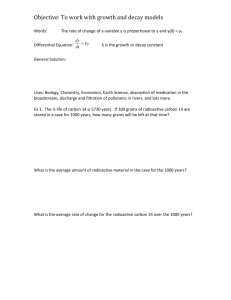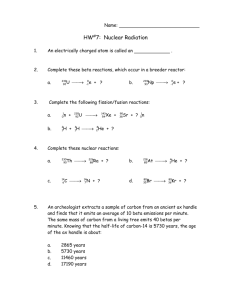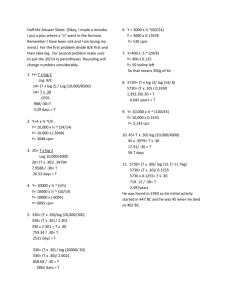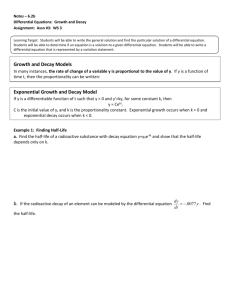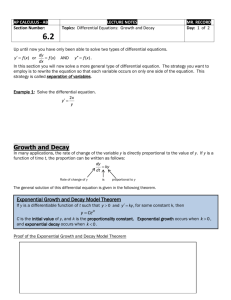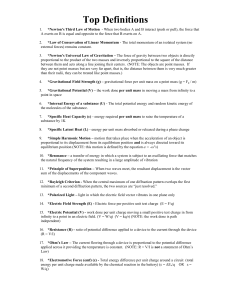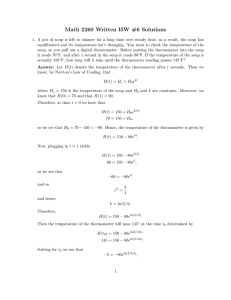differential equations - Uplift North Hills Prep
advertisement
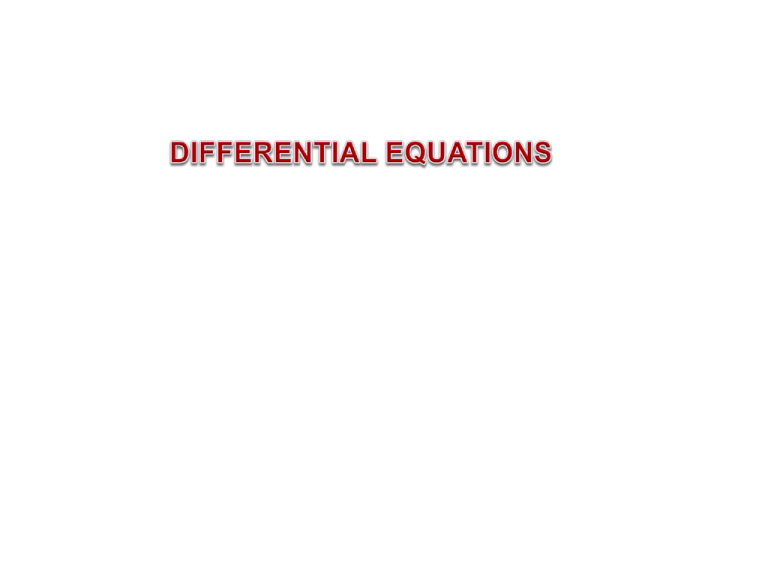
Differential Equations Definition Example A differential equation is an equation involving derivatives of an unknown function and possibly the function itself as well as the independent variable. y sin x , y ' 4 y 2 2 xy x 2 0, y y 3 x 0 1st order equations 2nd order equation The order of a differential equation is the highest order of the derivatives of the unknown function appearing in the equation In the simplest cases, equations may be solved by direct integration. Definition Examples y sin x y cos x C y 6 x e x y 3 x 2 e x C1 y x 3 e x C1x C2 Observe that the set of solutions to the above 1st order equation has 1 parameter, while the solutions to the above 2nd order equation depend on two parameters. Separable Differential Equations A separable differential equation can be expressed as the product of a function of x and a function of y. dy g x h y dx Example: dy 2 xy 2 dx dy 2 x dx 2 y 1 h y 0 separate the variables. (Assume y2 is never zero.) 2 y dy 2 x dx y C1 x C2 2 Combined constants of integration 1 y 2 x C 1 x2 C y In many natural phenomena, quantities grow or decay at a rate proportional to their size. The number of bighorn sheep in a population increases at a rate that is proportional to the number of sheep present (at least for awhile.) Indeed, under ideal conditions—unlimited environment, adequate nutrition, and immunity to disease—the mathematical model given by the equation 𝑦’ = 𝑘𝑦 predicts what actually happens fairly accurately. So does any population of living creatures. Other things that increase or decrease at a rate proportional to the amount present include radioactive material and money in an interest-bearing account. So if the rate of change is proportional to the amount present, the change can be modeled by: dy ky dt Law of Exponential Change – Law of Natural Growth or Decay 𝑑𝑦 If = 𝑘𝑦, then 𝑦 = 𝐶𝑒 𝑘𝑡 𝑑𝑡 where 𝐶 is the initial amount present (𝑦 intercept of the graph). k is either a growth or decay constant k is positive: equation represents growth. k is negative: equation represents decay. What is the significance of the proportionality constant k? In the context of population growth, where P(t) is the size of a population at time t, we can write: 1 𝑑𝑃 =𝑘 𝑃 𝑑𝑡 𝑘 is the growth rate divided by the population size. It is called the relative growth rate instead of saying “the growth rate is proportional to population size” we could say “the relative growth rate is constant.” Population with constant relative growth rate must grow exponentially. For instance, if 𝑑𝑃 = 0.02 𝑃 and t is measured in years, then the relative 𝑑𝑡 growth rate is 𝑘 = 0.02 and the population grows at a relative rate of 2% per year. If the population at time 0 is P0, then the expression for the population is: P(t) = P0e0.02t Example 1 Bacteria in a culture increased from 400 to 1600 in three hours. Assuming that the rate of increase is directly proportional to the population, a) Find an appropriate equation to model the population. b) Find the number of bacteria at the end of six hours. 𝑑𝑃 = 𝑘𝑃 𝑑𝑡 𝑎) 𝑡 = 0 𝑡 = 3 𝑃 = 𝑃0 𝑒 𝑘𝑡 → 𝑃 = 𝑃0 = 400 → 𝑃 = 400 𝑒 𝑘𝑡 𝑃 = 1600 → 1600 = 400 𝑒 3𝑘 𝑡 𝑃 = 400 4 𝑏) 𝑡 = 6 = 6400 𝑒𝑘 = 4 3 𝑃 = 400 42 If we were to solve for k rather than ek we might have the problem with rounding!! 𝑘= 1 ln 4 = 0.462 (𝑟𝑜𝑢𝑛𝑑𝑖𝑛𝑔) 3 → 𝑃 = 400 𝑒 0.462𝑡 𝑃 = 6396 𝑛𝑜𝑡 6400 𝑎𝑠 𝑏𝑒𝑓𝑜𝑟𝑒 1 3 → 𝑒 3𝑘 = 4 → 𝑒 𝑘𝑡 = 4 𝑡 3 by the way, k = 0.462098 → exponential growth Continuously Compounded Interest If money is invested in a fixed-interest account where the interest is added to the account r times per year, the amount present after t years is: 𝑘 P t = 𝑃0 1 + 𝑟 𝑟𝑡 If the money is added back more frequently, you will make a little more money. The best you can do is if the interest is added continuously. Of course, the bank does not employ some clerk to continuously calculate your interest with an adding machine. 𝑘 We could calculate P t = lim 𝑃0 1 + 𝑟→∞ 𝑟 We peek: 𝑟𝑡 if we only knew how (we’ll know) 𝑃(𝑡) = 𝑃0 𝑒 𝑘𝑡 interest is proportional to the amount present 𝑃′ = 𝑘P Example 3 Find the amount of money in a bank account with a 4% interest rate after 10 years if originally there was $5000 in it. 𝑃 = 5000 𝑒 0.04 𝑡 k = 0.04 P0 = 5000 t = 10 years 𝑃 = 5000 𝑒 0.04 (10) ≈ 7459.12 Radioactive Decay The equation for the amount of a radioactive element left after time t is: 𝑁 𝑡 = 𝑁0 𝑒 −𝑘𝑡 This allows the decay constant, k, to be positive. In problems: The half-life is the time required for half the material to decay. k is not a half-life Example 2 Carbon-14 has a half life of approximately 5730 years (every 5730 years, the amount of radioactive substance will be halved). It is often used in carbon dating to find the age of artifacts and fossils since the amount of carbon-14 in the atmosphere is known. Assume that a certain fossil has 30% as much carbon-14 as its present-day equivalent should have. Approximate the age of the fossil. 𝑑𝑃 = 𝑘𝑃 𝑑𝑡 → 𝑃 = 𝑃0 𝑒 𝑘𝑡 1 𝑃 = 𝑃0 2 𝑡 = 5730 𝑃 = 𝑃0 1 2 → 1 𝑃0 = 𝑃0 𝑒 5730 𝑘 2 𝑡 5730 𝑡 = ? 𝑓𝑜𝑟 𝑃 = 0.30 𝑃0 𝑡 ln 0.30 = ln 0.5 5730 𝑡 = 9953 𝑦𝑒𝑎𝑟𝑠 𝑒𝑘 = → 0.30 𝑃0 = 𝑃0 1 2 by the way, k = – 0.000120968 exponential decay 𝑡 5730 take 5730th root 1 2 1 5730 Newton’s Law of Cooling Espresso left in a cup will cool to the temperature of the surrounding air. The rate of cooling is proportional to the difference in temperature between the liquid and the air. (It is assumed that the air temperature is constant.) Newton's Law makes a statement about an instantaneous rate of change of the temperature. If we solve the differential equation: dT k T Ts we get: dt Newton’s Law of Cooling T Ts T0 Ts e kt where 𝑇𝑠 is the temperature of the surrounding medium, which is a constant. Example 4 A pot of liquid is put on the stove to boil. The temperature of the liquid reaches 170oF and then the pot is taken off the burner and placed on a counter in the kitchen. The temperature of the air in the kitchen is 76oF. After two minutes the temperature of the liquid in the pot is 123oF. How long before the temperature of the liquid in the pot will be 84oF? 𝑑𝑇 = 𝑘(𝑇 − 𝑇𝑠 ) 𝑑𝑡 𝑇 > 𝑇𝑠 𝑇 = 76 + 𝑒 𝑘𝑡+𝐶 𝑑𝑇 → = 𝑘 𝑑𝑡 𝑇 − 𝑇𝑠 → ln 𝑇 − 𝑇𝑠 = 𝑘𝑡 + 𝐶 → 𝑇 = 𝑇𝑠 + 𝑒 𝑘𝑡+𝐶 → 𝑇𝑠 = 76 → 𝑒 𝐶 = 94 𝑇 0 = 170 𝑇 = 76 + 94𝑒 𝑘𝑡 123 = 76 + 94𝑒 𝑇(2𝑚𝑖𝑛) = 123 𝑇 = 76 + 94 2 2 𝑡 84 = 76 + 94 𝑡 ≈ 7.109177 𝑚𝑖𝑛 ≈ 7.11 𝑚𝑖𝑛 → 2𝑘 2 2 𝑡 𝑒𝑘= 2 2 4 2 → ln = 𝑡 ln 47 2 𝑇 = 76 + 𝑒 𝑘𝑡+𝐶 𝑇 0 = 170 → 𝑒 𝐶 = 94 𝑇 = 76 + 94𝑒 𝑘𝑡 𝑇(2𝑚𝑖𝑛) = 123 123 = 76 + 94𝑒 2𝑘 → 𝑒𝑘= 2 2 The other way from here 𝑒 2𝑘 1 1 1 = → 𝑘 = ln ≈ −0.34657359 2 2 2 𝑇 = 76 + 94𝑒 −0.34657359 𝑡 84 = 76 + 94𝑒 −0.34657359 𝑡 𝑡 ≈ 7.109177 ≈ 7.11 𝑚𝑖𝑛 84 = 76 + 94𝑒 −0.347 𝑡 𝑡 ≈ 7.10044 ≈ 7.10 𝑚𝑖𝑛 𝑑𝑖𝑓𝑓𝑒𝑟𝑒𝑛𝑡 𝑟𝑜𝑢𝑛𝑑𝑖𝑛𝑔: 𝑘 ≈ −0.347 sometimes much bigger difference!!!!!!!!!!
